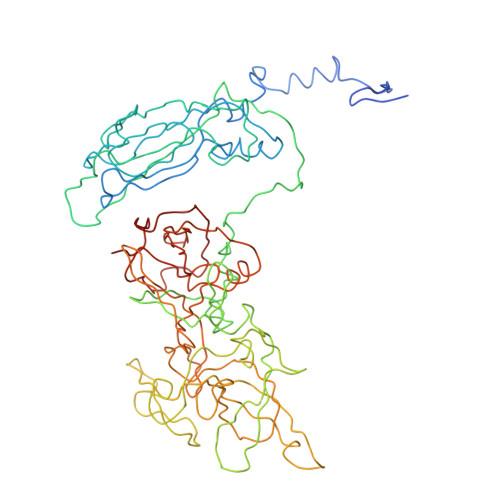Epitope Insertion at the N-Terminal Molecular Switch of the Rabbit Hemorrhagic Disease Virus T=3 Capsid Protein Leads to Larger T=4 Capsids.
Luque, D., Gonzalez, J.M., Gomez-Blanco, J., Marabini, R., Chichon, J., Mena, I., Angulo, I., Carrascosa, J.L., Verdaguer, N., Trus, B.L., Barcena, J., Caston, J.R.(2012) J Virol 86: 6470
- PubMed: 22491457
- DOI: https://doi.org/10.1128/JVI.07050-11
- Primary Citation of Related Structures:
3ZUE - PubMed Abstract:
Viruses need only one or a few structural capsid proteins to build an infectious particle. This is possible through the extensive use of symmetry and the conformational polymorphism of the structural proteins. Using virus-like particles (VLP) from rabbit hemorrhagic disease virus (RHDV) as a model, we addressed the basis of calicivirus capsid assembly and their application in vaccine design. The RHDV capsid is based on a T=3 lattice containing 180 identical subunits (VP1). We determined the structure of RHDV VLP to 8.0-Å resolution by three-dimensional cryoelectron microscopy; in addition, we used San Miguel sea lion virus (SMSV) and feline calicivirus (FCV) capsid subunit structures to establish the backbone structure of VP1 by homology modeling and flexible docking analysis. Based on the three-domain VP1 model, several insertion mutants were designed to validate the VP1 pseudoatomic model, and foreign epitopes were placed at the N- or C-terminal end, as well as in an exposed loop on the capsid surface. We selected a set of T and B cell epitopes of various lengths derived from viral and eukaryotic origins. Structural analysis of these chimeric capsids further validates the VP1 model to design new chimeras. Whereas most insertions are well tolerated, VP1 with an FCV capsid protein-neutralizing epitope at the N terminus assembled into mixtures of T=3 and larger T=4 capsids. The calicivirus capsid protein, and perhaps that of many other viruses, thus can encode polymorphism modulators that are not anticipated from the plane sequence, with important implications for understanding virus assembly and evolution.
- Department of Structure of Macromolecules, Centro Nacional de Biotecnología/CSIC, Cantoblanco, Madrid, Spain.
Organizational Affiliation:
















